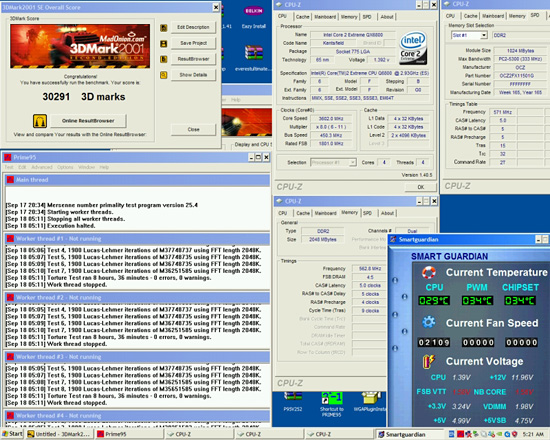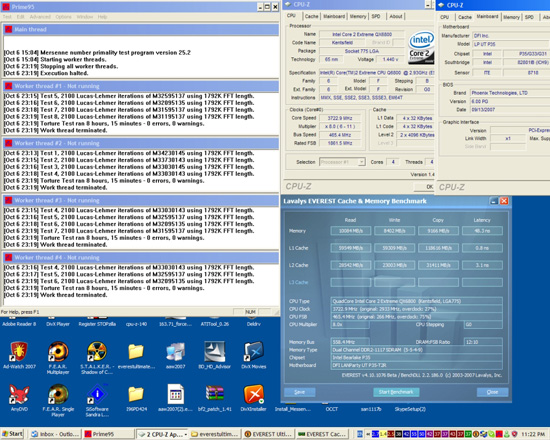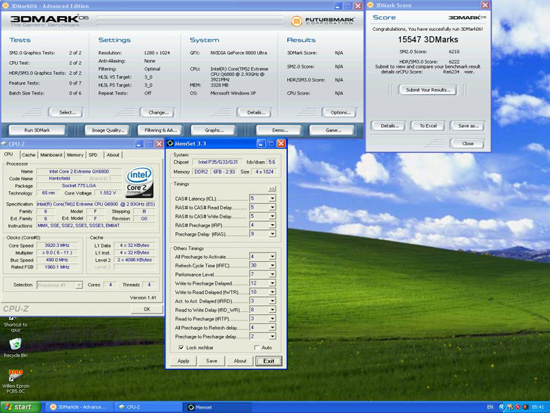DFI UT P35-T2R: Tweakers Rejoice!
by Rajinder Gill on October 18, 2007 2:00 PM EST- Posted in
- Motherboards
Quad-Core^4
Our BIOS settings for 450FSB with a quad-core CPU using 2GB of RAM
Parts used for this stability test
Qx6800 ES G0
OCZ ProXStream 100w
2GB OCZ Flex 9200 RAM
Tuniq Tower with additional Panaflo 120mm fan
WD2500 KS 250GB Hard Drive
Plextor 755a DVD/RW
NVIDIA 7600 GS
450FSB Stability Test
Water-Cooling
After attaining a decent 3.6GHz performance overclock on air-cooling, the decision was taken to move over to water-cooling for the CPU. Our QX6800 G0 ES is not one of the coolest running G0 CPUs around. Up to 3.6GHz the current G0 stepping quad-core CPUs all seem to be able to cope with less than 1.4V. However, cruising over 3.6GHz results in a non-linear VCore scaling process per CPU MHz increase. We found ourselves tapped out for further overhead with 100% CPU load tests. We were able to run most benchmarks at around 3.9GHz with the same air-cooling, with around 1.5Vcore to hold the CPU steady. Results placed on various forums have shown some users Prime95 stable for all software up to 3.8GHz with good CPUs using top-end air-cooling.
The following Water Cooling components were used for this test:
Swiftech Apogee GTX CPU waterblock
2x Petra Top Laing DDC Ultra water pumps in series
Swiftech Micro-Res
Thermochill PA120.3 Radiator, with 3x Panaflo 120mm fans
Danger Den 1/2" ID Tubing
This swap to water-cooling allowed us sufficient temperature overhead to run Prime95 type tests for 11 hours with speeds of 3.72GHz @ 465FSB on the 333 strap with 4GB of RAM, while holding 470FSB on the 266 strap and 2GB of memory stable at around 467FSB. A 5-7 FSB margin above Prime95 type testing is often usable for those who do not require absolute 100% load stability to find sleep at night.
Prime95 and Everest
We found that CPU scores in 3DMark06 using the DFI P35 T2R were higher than we were accustomed to on the acclaimed 975X chipset. We managed to push 4GB of RAM to 490FSB with water-cooling for a quick run of 3DMark06. The board at this point however was right on the ragged edge and would not run SuperPi 32M without a failure.
| DFI UT P35-T2R Overclocking Benchmark Testbed |
|
| Processor | Intel Core 2 Quad QX6800 ES - G0 Stepping Quad Core, 2.93GHz, 8MB Unified Cache, 11x Multiplier, 1066FSB Intel Core 2 Duo X6800 Dual Core, 2.93GHz, 4MB Unified Cache, 11x Multiplier, 1066FSB |
| CPU Voltage | 1.300V Base |
| Cooling | Various - Tuniq Tower, Swiftech Apogess GTX, Dual Rotary Cascade |
| Power Supply | OCZ ProXStream 1000W, PCP&C 1200W |
| Memory | OCZ Flex PC2-9200 (2x1GB, 4x1GB) |
| Memory Settings | 4-4-4-12 (DDR2-1066) |
| Video Cards | NVIDIA 8800GTX Ultra, NVIDIA 7600GS, NVIDIA 8800 GTS 640MB |
| Video Drivers | NVIDIA 163.44 |
| Hard Drive | Western Digital 7200RPM 250GB - WD2500KS |
| Optical Drives | Plextor PX-755A |
| Case | Cooler Master Stacker 830 Evo, Open Test Bed |
| BIOS | DFI 9/13 |
| Operating System | Windows XP Professional SP2 |
| . | |
Our BIOS settings for 450FSB with a quad-core CPU using 2GB of RAM
Parts used for this stability test
Qx6800 ES G0
OCZ ProXStream 100w
2GB OCZ Flex 9200 RAM
Tuniq Tower with additional Panaflo 120mm fan
WD2500 KS 250GB Hard Drive
Plextor 755a DVD/RW
NVIDIA 7600 GS
| 450FSB Quad-Core BIOS Settings | |
| CPU Feature | |
| Thermal Management Control | Disabled |
| PPM (EIST) Mode | Disabled |
| Limit CPUID MaxVal | Disabled |
| CIE Function | Disabled |
| Execute Disable Bit | Disabled |
| Virtualization Technology | Disabled |
| Core Multi-Processing | Enabled |
| Exist Setup Shutdown | Mode 2 |
| CLOCK VC0 divider | AUTO |
| CPU Clock Ratio | 8x |
| Target CPU Clock | 3600MHz |
| CPU Clock | 450FSB |
| Boot Up Clock | AUTO |
| DRAM Speed | 266MHz/667MHz |
| Target DRAM Speed | DDR2-1125MHz |
| PCIE Clock | 100MHz |
| Voltage Settings | |
| CPU VID Control | 1.39 |
| CPU VID Special Add | AUTO |
| DRAM Voltage Control | 2.1 |
| SB 1.05V Voltage | 1.07v |
| SB Core/CPU PLL Voltage | 1.55v |
| NB Core Voltage | 1.61 |
| CPU VTT Voltage | 1.60v |
| VCore Droop Control | Disabled |
| Clockgen Voltage Control | 3.45v |
| GTL+ Buffers Strength | Strong |
| Host Slew Rate | Weak |
| GTL REF Voltage Control | Enabled |
| x CPU GTL1/3 REF Volt | 115 |
| x CPU GTL 0/2 REF Volt | 114 |
| x North Bridge GTL REF Volt | 117 |
| DRAM Timing | |
| Enhance Data transmitting | FAST |
| Enhance Addressing | FAST |
| T2 Dispatch | Disabled |
| Channel 1 CLK Crossing Setting | More Aggressive |
| Channel 2 CLK Crossing Setting | More Aggressive |
| CH1CH2 Common CLK Crossing Setting | More Aggressive |
| CAS Latency Time (tCL) | 5 |
| RAS# to CAS# Delay (tRCD) | 5 |
| RAS# Precharge (tRP) | 4 |
| Precharge Delay (tRAS) | 9 |
| All Precharge to Act | 4 |
| REF to ACT Delay (tRFC) | 30 |
| Performance Level | 6 |
| Read delay phase adjust | AUTO |
| MCH ODT Latency | 1 |
| Write to PRE Delay (tWR) | 12 |
| Rank Write to Read (tWTR) | 10 |
| ACT to ACT Delay (tRRD) | 3 |
| Read to Write Delay (tRDWR) | 8 |
| Ranks Write to Write (tWRWR) | AUTO |
| Ranks Read to Read (tRDRD) | AUTO |
| Ranks Write to Read (tWRRD) | AUTO |
| Read CAS# Precharge (tRTP) | 3 |
| ALL PRE to Refresh | 4 |
| PCIE Slot Config | 1X 1X |
| CPU Spread Spectrum | Disabled |
| PCIE Spread Spectrum | Disabled |
| SATA Spread Spectrum | Disabled |
450FSB Stability Test
 |
Water-Cooling
After attaining a decent 3.6GHz performance overclock on air-cooling, the decision was taken to move over to water-cooling for the CPU. Our QX6800 G0 ES is not one of the coolest running G0 CPUs around. Up to 3.6GHz the current G0 stepping quad-core CPUs all seem to be able to cope with less than 1.4V. However, cruising over 3.6GHz results in a non-linear VCore scaling process per CPU MHz increase. We found ourselves tapped out for further overhead with 100% CPU load tests. We were able to run most benchmarks at around 3.9GHz with the same air-cooling, with around 1.5Vcore to hold the CPU steady. Results placed on various forums have shown some users Prime95 stable for all software up to 3.8GHz with good CPUs using top-end air-cooling.
The following Water Cooling components were used for this test:
Swiftech Apogee GTX CPU waterblock
2x Petra Top Laing DDC Ultra water pumps in series
Swiftech Micro-Res
Thermochill PA120.3 Radiator, with 3x Panaflo 120mm fans
Danger Den 1/2" ID Tubing
This swap to water-cooling allowed us sufficient temperature overhead to run Prime95 type tests for 11 hours with speeds of 3.72GHz @ 465FSB on the 333 strap with 4GB of RAM, while holding 470FSB on the 266 strap and 2GB of memory stable at around 467FSB. A 5-7 FSB margin above Prime95 type testing is often usable for those who do not require absolute 100% load stability to find sleep at night.
Prime95 and Everest
 |
We found that CPU scores in 3DMark06 using the DFI P35 T2R were higher than we were accustomed to on the acclaimed 975X chipset. We managed to push 4GB of RAM to 490FSB with water-cooling for a quick run of 3DMark06. The board at this point however was right on the ragged edge and would not run SuperPi 32M without a failure.
 |










30 Comments
View All Comments
Rocket321 - Tuesday, October 23, 2007 - link
I would like to see the overclocking results put into a graph or chart of some kind.I guess tweakers might like the screenshots as "proof" that the overclock ran, but personally I trust you and would rather just have one place to look rather than clicking to enlarge multiple screenshots sequentially.
It was a great review though, I look forward to the future tweaker guides & reviews.
Raja Gill - Wednesday, October 24, 2007 - link
There will be a more typical Anandtech look to future articles, with the DFI board revisited for a round up on a suite of benchmarks, this will be used to cross compare with other boards, clocked to equivalent with board maximums in the range and voltage. In terms of the screenshots, it is nice to have 1 persons trust, but there are many we have to please and not everyone is always as convinced..thanks for the suggestions..
Next up is the Asus Maximus Formula..
regards
Raja
Jodiuh - Thursday, October 25, 2007 - link
Specifically Windvd conversions from divx/xvid to DVD would be wonderful as I've found this app benefits from a solid OC.beoba - Friday, October 19, 2007 - link
It'd be great if this came with a glossary."Strap"?
retrospooty - Saturday, October 20, 2007 - link
strap is a term used for memory clocking. for example, at 266mhz bus, memory can be "strapped" to one of the following.266x(stap2)=533 or DDR 1066
266x(strap1.5)=400 or DDR 800
266x(strap1.25)=333 or DDR 666
If you are running at stock 266 there is no way to have DDR 950 because it has to be strapped to one of the above settings.
I use the 1/1 strap so my bus speed is 500x(strap1)=500 or DDR 1000, in most cases 1/1 is the most efficient, if you can utilize it with your particular hardware, do it.
Avalon - Thursday, October 18, 2007 - link
Unfortunately, DFI's asking price of admission continues to rise for each new board they release. I was mildly annoyed when they started selling boards for $200+ that had little to no tangible benefit over $100-$150 boards, but now they're at the $300 mark? No thanks.This board is for someone who likes to spend his time tweaking and not actually using his computer.
retrospooty - Saturday, October 20, 2007 - link
"This board is for someone who likes to spend his time tweaking and not actually using his computer."The article title is called "Tweakers Rejoice" after all. The idea is not to tweak forever . I did spend alot of time over the first few weeks, but now that its tweaked, I just use it as is.
Avalon - Sunday, October 21, 2007 - link
Yes, I am quite capable of reading the article title. My whole point is that you are working for diminishing returns that I feel could be better spent using your system. If you're doing it to set a record, fantastic. I support that.retrospooty - Sunday, October 21, 2007 - link
Understood... This is obviously not the motherboard for you. I personally love the BIOS options and CMOS reloaded functionality. That alone makes the extra cost well worth it to me. Asus BIOS just sucks, and I have had too many quality problems with them in the past, and Gigabyte just underperforms. I like to know I will not be held back by my motherboard for the next couple of CPU's I buy (will likely get a dual core Penryn on release for under $200, then a high end quad core Penryn a year or so later when it is under $200).I do see your point, but in spite of this article's stock speed comparison (totally pointless for a OC geared mobo), and similar results with one particular CPU, that looks as if it has an FSB limit equal on all 3 boards (meaning the CPU is holding it back) This board overclocks and performs better than any ASUS, or Gigabyte, or any other board out there. If AT tested the max FSB limits on a dozen or so CPU's, or if they had a "golden sample" that had a high FSB limit, you would see the difference. Also if they had time to test many diff RAM stocks and to tweak the memory settings you would also see the difference. Its a good article, but no reviewer has time to really dig into this mobo and all it has to offer. I do feel the article did a good job at explaining that.
JNo - Sunday, October 21, 2007 - link
"I like to know I will not be held back by my motherboard for the next couple of CPU's I buy"I don't know much about overclocking and I hold your views valid Retrospooty but surely this is still a lot of money that will still be needed to replaced in the short/medium-term if a) you want to start using DDR3 once prices come down b) if GPUs come out that take advantage of PCI-E 2 standard (as used on X38). So all that money is only paying for great OC'ing potential for *now* only... no?